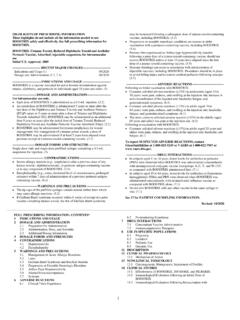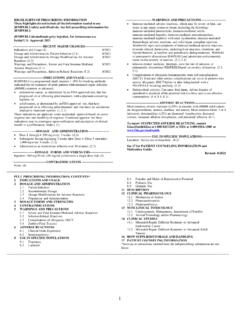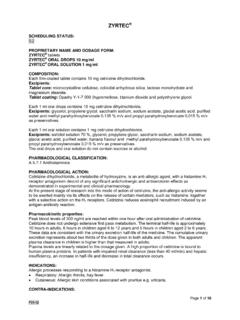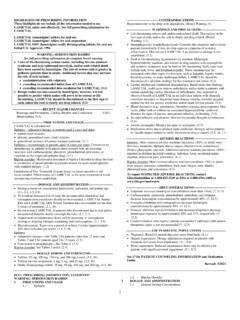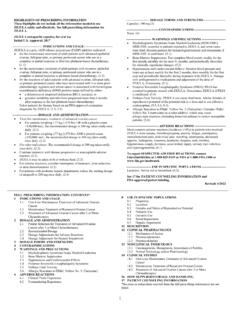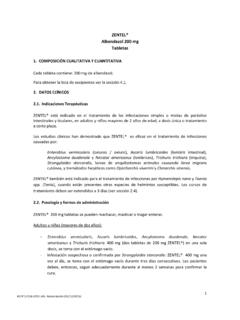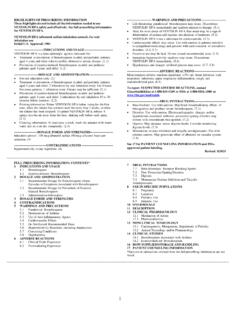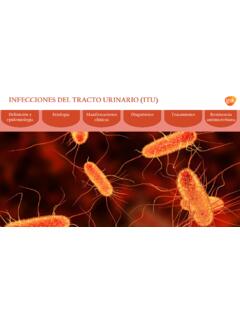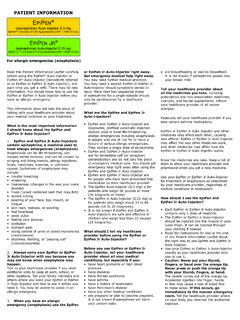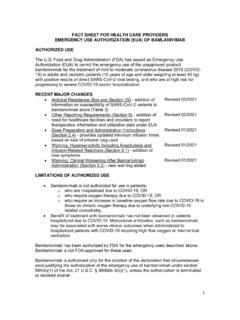Transcription of NUCALA (mepolizumab) for injection NUCALA ... - GSKpro
1 1 HIGHLIGHTS OF PRESCRIBING INFORMATION These highlights do not include all the information needed to use NUCALA safely and effectively. See full prescribing information for NUCALA . NUCALA (mepolizumab) for injection , for subcutaneous use NUCALA (mepolizumab) injection , for subcutaneous use Initial Approval: 2015 ----------------------------- RECENT MAJOR CHANGES --------------------------- Indications and Usage, Maintenance Treatment of Chronic Rhinosinusitis with Nasal Polyps ( ) 7/2021 Dosage and Administration, Chronic Rhinosinusitis with Nasal Polyps ( ) 7/2021 Dosage and Administration, Preparation and Administration of NUCALA injection prefilled Autoinjector and prefilled Syringes ( ) 1/2022 ----------------------------- INDICATIONS AND USAGE ---------------------------- NUCALA is an interleukin-5 (IL-5) antagonist monoclonal antibody (IgG1 kappa) indicated for: Add-on maintenance treatment of adult and pediatric patients aged 6 years and older with severe asthma and with an eosinophilic phenotype.
2 ( ) Add-on maintenance treatment of adult patients 18 years and older with chronic rhinosinusitis with nasal polyps (CRSwNP). ( ) The treatment of adult patients with eosinophilic granulomatosis with polyangiitis (EGPA). ( ) The treatment of adult and pediatric patients aged 12 years and older with hypereosinophilic syndrome (HES) for 6 months without an identifiable non-hematologic secondary cause. ( ) Limitations of use: Not for relief of acute bronchospasm or status asthmaticus. ( ) ------------------------- DOSAGE AND ADMINISTRATION ----------------------- Severe asthma in patients aged 12 years and older: 100 mg administered subcutaneously once every 4 weeks. ( ) Severe asthma in patients aged 6 to 11 years: 40 mg administered subcutaneously once every 4 weeks. ( ) CRSwNP: 100 mg administered subcutaneously once every 4 weeks. ( ) EGPA: 300 mg as 3 separate 100-mg injections administered subcutaneously once every 4 weeks. ( ) HES: 300 mg as 3 separate 100-mg injections administered subcutaneously once every 4 weeks.
3 ( ) ---------------------- DOSAGE FORMS AND STRENGTHS---------------------- for injection : 100 mg of lyophilized powder in a single-dose vial for reconstitution. (3) injection : 100 mg/mL, single-dose prefilled autoinjector or single-dose prefilled syringe. (3) injection : 40 mL, single-dose prefilled syringe. (3) ------------------------------- CONTRAINDICATIONS ------------------------------ History of hypersensitivity to mepolizumab or excipients in the formulation. (4) ------------------------ WARNINGS AND PRECAUTIONS ----------------------- Hypersensitivity reactions ( , anaphylaxis, angioedema, bronchospasm, hypotension, urticaria, rash) have occurred after administration of NUCALA . Discontinue NUCALA in the event of a hypersensitivity reaction. ( ) Do not use to treat acute bronchospasm or status asthmaticus. ( ) Herpes zoster infections have occurred in patients receiving NUCALA . Consider vaccination if medically appropriate. ( ) Do not discontinue systemic or inhaled corticosteroids abruptly upon initiation of therapy with NUCALA .
4 Decrease corticosteroids gradually, if appropriate. ( ) Treat patients with pre-existing helminth infections before therapy with NUCALA . If patients become infected while receiving treatment with NUCALA and do not respond to anti-helminth treatment, discontinue NUCALA until parasitic infection resolves. ( ) ------------------------------- ADVERSE REACTIONS ------------------------------ Most common adverse reactions (incidence 5%): Asthma: Headache, injection site reaction, back pain, and fatigue. ( ) CRSwNP: Oropharyngeal pain and arthralgia. ( ) EGPA and HES: Most common adverse reactions are similar to asthma. ( , ) To report SUSPECTED ADVERSE REACTIONS, contact GlaxoSmithKline at 1-888-825-5249 or FDA at 1-800-FDA-1088 or See 17 for PATIENT COUNSELING INFORMATION and FDA-approved patient labeling. Revised: 1/2022 _____ FULL PRESCRIBING INFORMATION: CONTENTS* 1 INDICATIONS AND USAGE Maintenance Treatment of Severe Asthma Maintenance Treatment of Chronic Rhinosinusitis with Nasal Polyps Eosinophilic Granulomatosis with Polyangiitis Hypereosinophilic Syndrome 2 DOSAGE AND ADMINISTRATION Severe Asthma Chronic Rhinosinusitis with Nasal Polyps Eosinophilic Granulomatosis with Polyangiitis Hypereosinophilic Syndrome Preparation and Administration of NUCALA for injection Vial Preparation and Administration of NUCALA injection prefilled Autoinjector and prefilled Syringe 3 DOSAGE FORMS AND STRENGTHS 4 CONTRAINDICATIONS 5 WARNINGS AND PRECAUTIONS Hypersensitivity Reactions Acute Asthma Symptoms or Deteriorating Disease Opportunistic Infections.
5 Herpes Zoster Reduction of Corticosteroid Dosage Parasitic (Helminth) Infection 6 ADVERSE REACTIONS Clinical Trials Experience in Severe Asthma Clinical Trials Experience in Chronic Rhinosinusitis with Nasal Polyps Clinical Trials Experience in Eosinophilic Granulomatosis with Polyangiitis Clinical Trials Experience in Hypereosinophilic Syndrome Immunogenicity Postmarketing Experience 7 DRUG INTERACTIONS 8 USE IN SPECIFIC POPULATIONS Pregnancy Lactation Pediatric Use Geriatric Use 10 OVERDOSAGE 11 DESCRIPTION 12 CLINICAL PHARMACOLOGY Mechanism of Action Pharmacodynamics Pharmacokinetics 13 NONCLINICAL TOXICOLOGY Carcinogenesis, Mutagenesis, Impairment of Fertility 14 CLINICAL STUDIES Severe Asthma Chronic Rhinosinusitis with Nasal Polyps Eosinophilic Granulomatosis with Polyangiitis Hypereosinophilic Syndrome 16 HOW SUPPLIED/STORAGE AND HANDLING 17 PATIENT COUNSELING INFORMATION *Sections or subsections omitted from the full prescribing information are not listed.
6 _____ 2 FULL PRESCRIBING INFORMATION 1 INDICATIONS AND USAGE Maintenance Treatment of Severe Asthma NUCALA is indicated for the add-on maintenance treatment of adult and pediatric patients aged 6 years and older with severe asthma and with an eosinophilic phenotype [see Use in Specific Populations ( ), Clinical Studies ( )]. Limitations of Use NUCALA is not indicated for the relief of acute bronchospasm or status asthmaticus. Maintenance Treatment of Chronic Rhinosinusitis with Nasal Polyps NUCALA is indicated for the add-on maintenance treatment of chronic rhinosinusitis with nasal polyps (CRSwNP) in adult patients 18 years of age and older with inadequate response to nasal corticosteroids. Eosinophilic Granulomatosis with Polyangiitis NUCALA is indicated for the treatment of adult patients with eosinophilic granulomatosis with polyangiitis (EGPA). Hypereosinophilic Syndrome NUCALA is indicated for the treatment of adult and pediatric patients aged 12 years and older with hypereosinophilic syndrome (HES) for 6 months without an identifiable non-hematologic secondary cause.
7 2 DOSAGE AND ADMINISTRATION NUCALA is for subcutaneous use only. Severe Asthma Adults and Adolescents Aged 12 Years and Older The recommended dosage of NUCALA in adults and adolescents aged 12 years and older is 100 mg administered once every 4 weeks by subcutaneous injection i nto the upper arm, thigh, or abdomen [see Dosage and Administration ( , )]. Pediatric Patients Aged 6 to 11 Years The recommended dosage of NUCALA for injection in pediatric patients aged 6 to 11 years is 40 mg administered once every 4 weeks by subcutaneous injection into the upper arm, thigh, or abdomen [see Dosage and Administration ( , )]. 3 Chronic Rhinosinusitis with Nasal Polyps The recommended dosage of NUCALA is 100 mg administered once every 4 weeks by subcutaneous injection into the upper arm, thigh, or abdomen [see Dosage and Administration ( , )]. Eosinophilic Granulomatosis with Polyangiitis The recommended dosage of NUCALA is 300 mg administered once every 4 weeks by subcutaneous injection as 3 separate 100-mg injections into the upper arm, thigh, or abdomen [see Dosage and Administration ( , )].
8 Administer individual 100-mg injections at least 5 cm (approximately 2 inches) apart. Hypereosinophilic Syndrome The recommended dosage of NUCALA is 300 mg administered once every 4 weeks by subcutaneous injection as 3 separate 100-mg injections into the upper arm, thigh, or abdomen [see Dosage and Administration ( , )]. Administer individual 100-mg injections at least 5 cm (approximately 2 inches) apart. Preparation and Administration of NUCALA for injection Vial NUCALA for injection should be reconstituted and administered by a healthcare professional. In line with clinical practice, monitoring of patients after administration of biologic agents is recommended [see Warnings and Precautions ( )]. Reconstitution Instructions 1. Reconstitute NUCALA for injection in the vial with mL of Sterile Water for injection , USP, preferably using a 2- or 3-mL syringe and a 21-gauge needle. The reconstituted solution will contain a concentration of 100 mg/mL mepolizumab.
9 Do not mix with other medications. 2. Direct the stream of Sterile Water for injection vertically onto the center of the lyophilized powder, which may have a cake-like appearance. Gently swirl the vial for 10 seconds with a circular motion at 15-second intervals until the powder is dissolved. Note: Do not shake the reconstituted solution during the procedure as this may lead to product foaming or precipitation. Reconstitution is typically complete within 5 minutes after the Sterile Water for injection has been added, but it may take additional time. 3. If a mechanical reconstitution device (swirler) is used to reconstitute NUCALA for injection , swirl at 450 rpm for no longer than 10 minutes. Alternatively, swirling at 1,000 rpm for no longer than 5 minutes is acceptable. 4. Visually inspect the reconstituted solution for particulate matter and clarity before use. The solution should be clear to opalescent and colorless to pale yellow or pale brown, essentially particle free.
10 Small air bubbles, however, are expected and acceptable. If particulate matter 4 remains in the solution or if the solution appears cloudy or milky, the solution must not be administered. 5. If the reconstituted solution is not used immediately: store below 30 C (86 F), do not freeze, and discard if not used within 8 hours of reconstitution. Administration of 100-mg Dose 1. For subcutaneous administration, preferably using a 1-mL polypropylene syringe fitted with a disposable 21- to 27-gauge x (13-mm) needle. 2. Just before administration, remove 1 mL of reconstituted NUCALA for injection . Do not shake the reconstituted solution during the procedure as this could lead to product foaming or precipitation. 3. Administer the 1-mL injection (equivalent to 100 mg of mepolizumab) subcutaneously into the upper arm, thigh, or abdomen. Administration of 40-mg Dose 1. For subcutaneous administration, preferably using a 1-mL polypropylene syringe fitted with a disposable 21- to 27-gauge x (13-mm) needle.
